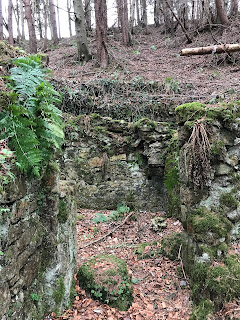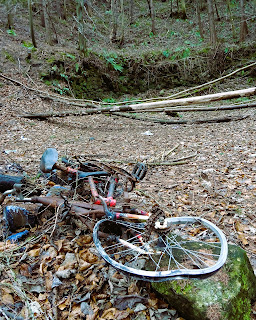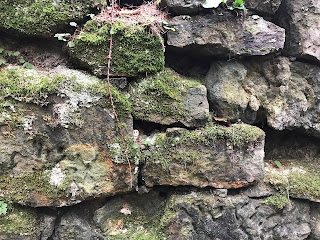Crampton
Tower in Broadstairs sits just across from the railway station. Looking like
the remains of a tower castle, this flint building was originally built in 1859
as part of Broadstairs public water supply. Water was pumped to the Tower from
a well at its base, and this was supplemented from a small reservoir housed in
a small dome shaped building close by.
The
Tower was designed by Thomas Crampton, a Victorian engineer who mainly designed railways and locomotives, but was also
responsible for the laying of the first effective telegraph cable under the
English Channel.
In
1901 the District Council took over the supply of water to Broadstairs. Due to
increased demand, water was pumped from elsewhere and the water supply from the
Tower was used only in emergencies.
The
Tower was eventually closed and now houses a museum in which are exhibited the working
drawings and models of Thomas Crampton’s train designs, as well as various
model railways.
Unfortunately,
having not paid attention to the visiting times, the Tower and museum were
closed when I arrived.
So, rather than relay you with details of my wanderings there, I’ll tell the story of a
rather explosive, unsolved murder than happened just down the street from
the Tower.
Richard
Richards was a ‘property owner and man of means’ who lived with his family in
Broadstairs. In
1893 he was having a coffee house built near to the railway station and would
often pop up to chat with the builder to see how work was progressing.
Richard
had a brother, William, who lived in Somerset, but also resided on occasions in
London. The two brothers had a fiery
relationship and every so often they’d fall out
over something, make up for a bit and then fall out again. Their relationship with each other
disintegrated into acrimony in 1893, when William sued Richard over a property
deal that had gone sour. William won the case and was awarded the princely sum of £1,200 (around £127,000 in today’s
money). Richard
then sued William in a counter claim and was also proposing to sue him for
libel. William
was not happy about this and wrote several angry letters to Richard telling him
that he’d have him found guilty of fraud and get
him sent to a penal colony for seven years. Not having Richard’s address in
Broadstairs, he sent his letters to Richard’s solicitor in London, so they
could be forwarded on. They were, and Richard complained bitterly to his wife
about them and about his brother.
Sometime
in July 1893, Richard was up in London when he bumped into the clerk from his
solicitor’s office, Frederick Colverd. Frederick told him that a parcel had
arrived that morning addressed to him and asked if he wanted to attend at the
office to collect it.
Richard told him that he wouldn’t have
time and asked him just to forward it on to his home in Broadstairs. Frederick
agreed to this and duly posted the parcel on, however not before noting that
‘it was addressed in a shaky hand, apparently the writing of a female…’ and
that ‘the writing seemed to be disguised.’
On
the morning of 22nd July 1893, Richard Richards was having breakfast
with his wife Katherine, when the postman delivered
the parcel forwarded on from London. Katherine immediately stated to Richard
that she didn’t like the look of it and thought he
should not open it.
Richard, on examining it, stated that he thought the writing looked
like that of his brother William. Not quite sure
what to do with the parcel, Richard decided to seek out a second opinion, so
off he marched, accompanied by Katherine and their children, to the property he
was having built.
There he called on the builder, Charles Martin and handed him the
parcel joking that it was a present for him. Charles laughed at this, but then agreed with
Katherine that it looked quite suspicious. But what to do about it? Both Richard
and Charles then stood examining the parcel and chatting about it. After a while they agreed that the only thing
to do was to open it and see just what it was. Katherine begged Richard not to open it,
but he shooed her away and cut the string around it with his penknife. Charles moved
closer to see what the parcel contained just as Richard pulled the string away. BOOM! There was a huge explosion that knocked
Katherine and the children to the ground and blew both Richard and Charles
across the road.
Katherine rose to her feet screaming – ‘My God! It’s an
infernal machine.’ Distraught, she and
her children were led away as passersby ran to help her husband and Charles. Charles who
was bleeding heavily from lacerations to his face and shaking with shock, was
helped back to his home. However, Richard was in a terrible state. Half his face
and his left hand had been blown away and his chest was torn open. He was quickly taken to the Seamen’s
Infirmary at Ramsgate, where it was realised there
was little they could do for him. There he made
a deposition to a local magistrate telling him about the suspicious package and
that he suspected that his brother William had sent it. He then lapsed into unconsciousness and
died the next day.
A
few weeks after Richard’s death an inquest was held. During this, both Katherine and Richard’s
solicitor gave evidence about the ill will between the brothers. Katherine stated that the writing on the
parcel looked like William’s and that her husband had no other enemies in life
other than his brother. Richard’s solicitor told of receiving the parcel for
Richard and noting the postmark on it. When asked about the letters William had
sent to his brother, the solicitor acknowledged that they bore the postmark of
the district next to the one that the parcel had been posted from. An explosives
expert then gave evidence that on examining the remains of the device it
appeared to have been gunpowder that had been used. He commented that it was a simple device
and would be easy to construct. William, Richard’s brother was then
called to give evidence. He was cautioned by the coroner and asked
if he had been responsible for sending the parcel to his brother. To this he
replied – ‘I have never made an infernal machine, or
employed anyone to do so.’ He then went
on to state that he would have gained no benefit if his brother was to die, as the judgement against his brother for
the £1,200 had been made void by his death.
At
the end of the inquest the coroner summed up the evidence and stated that
though there had been much ill will between the brothers there was not enough
evidence to show that William had in anyway been involved in Richard’s death. He also ruled
out suicide saying that there was ‘not a semblance of evidence to support
it.’ The jury then returned a verdict of
‘wilful murder by the explosion of a parcel received by the deceased, but by
whom sent there was no evidence to show.’
To
this day the case is unsolved. Was it an elaborate suicide by a man who
had taken on too much debt? Probably not. Maybe a spurned lover, what with the
feminine handwriting on the parcel?
Again, probably not. So, most likely it was William. So much for brotherly love. Just as well
I’m not writing this in 1893 though, as several newspapers named William as the
main suspect for his brother’s murder, and he sued them all. They all then hurriedly printed retractions.
Getting
back to Crampton Tower, which must have witnessed the explosive events of 1893,
I wandered round to the dome shaped building that once housed the reservoir and left a Skulferatu resting on a flint ledge there.
The
coordinates for the location of the Skulferatu are –
Latitude
51.359921
Longitude
1.433225
what3words:
sling.pitch.lion
I
used the following sources for information on Crampton Tower and on the murder
of Richard Richards –
Annual Report of the Medical Officer of Health
for the Year 1954 - Broadstairs and St Peter's
The Illustrated Police News – July 24th,
1893
Lloyds Weekly London Newspaper – Aug 6th,
1893
The People, Sunday Aug 6th, 1893
The Paddington, Kensington
and Bayswater Chronicle – Saturday 29 July 1893
Thanet Advertiser - Saturday 29 July 1893

























